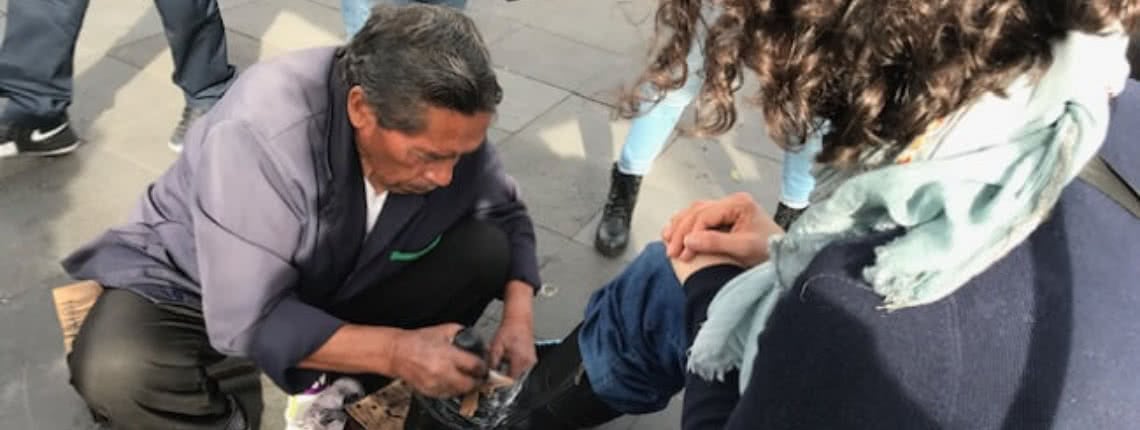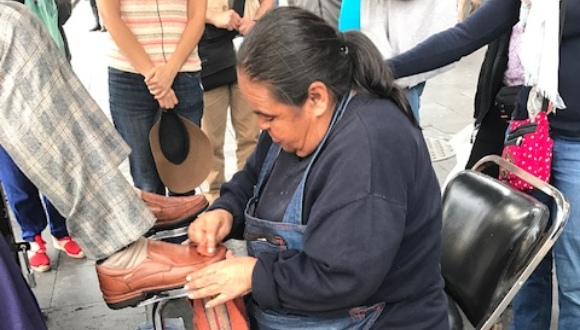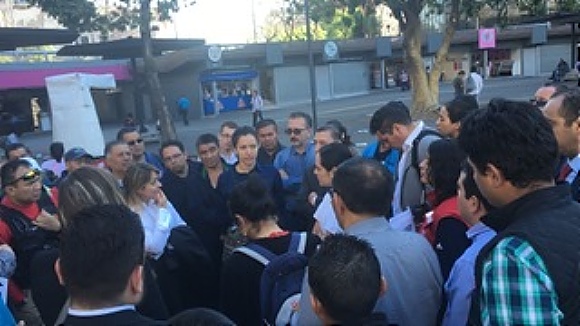
Shoe shiners in Mexico City have worked in Glorieta de Insurgentes Square for decades to earn their livelihoods. When they were unceremoniously evicted by the municipality under the guise of modernization, they decided to fight back.
Everyone wants to look spiffy in the city, and in Mexico City, shoe shiners have kept residents looking their very best for decades.
But Mexico City, like cities around the world, is changing. The city is rapidly upgrading and on its high-speed quest to “modernize”, beloved informal micro-businesses are being pushed out without discussion or notice.
The shoe shiners of Glorieta de Insurgentes Square have experienced this change firsthand.
The 5:00 a.m. eviction
For nearly 50 years, 27 shoe shiners in Mexico City’s busy pedestrian square have set up their popular outdoor service for clients emerging from the local metro. For just 20 pesos (~$1) and in less than 10 minutes, office- and school-goers go from shabby to chic as their heels and wing-tips are cleaned, waxed and buffed back into shape.
But at 5:00 a.m. on November 5, 2017, those services quickly came to a halt when two early-arriving shoe shiners were met not by customers but by the police. Within minutes, the workers were thrown out of the square indefinitely, as officials claimed they were in the way of ongoing renovations of the space.
On its high-speed quest to “modernize”, beloved informal micro-businesses are being pushed out.
“Cities are displacing hard-working people under the guise of ‘modernization’,” explains WIEGO’s Focal City Coordinator in Mexico City, Tania Espinosa. “This is not right. People are losing their livelihoods — the sole source of income they’ve had for most of their lives. Cities need to think about why these workers are there and the invaluable services they are providing to residents.”
Espinosa, a human rights lawyer by training, along with the Shoe Shiners Union president, Víctor Miguel Perez Serrano, teamed up to fight the case. They brought it before the Human Rights Commission, familiar ground to Serrano who had been there before to fight for shoe shiners across the city without much success. This time he had WIEGO strategizing by his side, and, after a long battle, the shoe shiners won their places back for the first time.
The story of how shoe shiners in Glorieta de Insurgentes Square got back their right to work is a fascinating example of the importance of organizing — and of the ongoing challenges workers face as cities aim for a future disjointed with the everyday reality of its people.

Shoe shiners in a modernizing Mexico City
Shoe shiners can be found all over Mexico City, and a decent percentage — between 15 per cent to 20 per cent — are women. As quaint and simple as these businesses can look, for the workers, they are vital sources of daily income. They set up their solo businesses out of necessity to pay their bills and feed their children. Without work, they are left with nothing.
Cities are displacing hard-working people under the guise of ‘modernization’, explains WIEGO’s Focal City Coordinator in Mexico City, Tania Espinosa.
Jose Eulogio Morales, 65, is the oldest shoe shiner in Glorieta de Insurgentes Square and had never faced eviction in his 47 years of operating there. However, in 2017, the city government was undertaking a major, $6.5 million overhaul of the space by adding new lamp posts, fountains, public bathrooms, 14 small huts, free wifi and even USB connections. The park would soon have all the shiny fixings of what the future city was supposed to be. With a goal to “improve and modernize”, the shoe shiners were seen as a relic of the past.
Some officials promised the shoe shiners that they would be able to return after renovations. But even with many of them holding valid permits to work in the public space, they were not allowed back.
The shoe shiners decided they needed to challenge the city.

The highly organized Shoe Shiners Union of Mexico City
The Shoe Shiners Union, with 3,500-4,000 members, is one of the oldest and largest unions in Mexico City and has been around since the Mexican Revolution in 1910. In 1934, shoe shiners were regularized in Mexico City. A reform to that “regularization” — that is, that shoe shiners could work in the city’s public spaces with a valid permit — was passed in 1975 and continues to be valid today, no matter how officials envision an urban future sanitized of these workers.
The union has played an essential role in resolving problems both locally for shoe shiners, as well as on the city. It is divided into 53 sectors, and each sector is led by a trained delegate who is responsible for sorting out conflicts with authorities, as well as ensuring shoe shiners are neat and tidy, sober and not overly insistent on people using their services.
The story of how shoe shiners in Glorieta de Insurgentes Square got back their right to work is a fascinating example of the importance of organizing.
“The Union has a strong leader, as well as a strong internal organization and capacity for worker mobilization,” explains Espinosa. “These were very important strengths during the whole process, and the positive outcome wouldn’t have been possible if they were not as well organized.”
When the shoe shiners from Glorieta de Insurgentes were evicted, for example, Eulogio, the designated delegate for the area, called the union’s leader immediately. They held an emergency meeting with the union’s executive, including all 53 delegates. The group tried approaching several institutions involved, such as the Metro and the Central Government, to defend the evicted workers, but they received no response.
Something else needed to be done.

A fight for their rights: Straight to the Human Rights Commission
In April 2018, the Shoe Shiners Union of Mexico City, along with WIEGO, decided enough was enough.
They filed a complaint at the city’s Human Rights Commission, stating that many of the shoe shiners — 21 out of the 27 — in the square had permits and the right to work there. The Commission opened a case and carried out several field visits, even interviewing shoe shiners.
The process was slow, and in the year while they were waiting, shoe shiners needed to work. Many tried relocating to new, sometimes nearby areas, to keep their families afloat. Not working was not an option.
Jose Eulogio Morales, 65, is the oldest shoe shiner in Glorieta de Insurgentes Square and had never faced eviction in his 47 years of operating there.
In 2018, the Commission came back suggesting officials should solve the case by letting shoe shiners back to the square. However, officials always had excuses for why that would create chaos in their new, upgraded space. Metro representatives, for example, argued that pedestrians and public transit users should be given priority and that shoe shiners were an obstacle to them.
“Authorities did not say anything openly against the shoe shiners, but many of them used the idea of pedestrian and civil security to argue against the workers’ return,” says Espinosa.
The Commission decided to organize a site visit with all parties — both authorities and the workers — to collaboratively decide on spaces within the park where the shoe shiners could set up again.
The Shoe Shiners Union, with 3,500-4,000 members, is one of the oldest and largest unions in Mexico City.
Although officials continued to resist, a Secretariat of the Government representative decided to move things forward by pointing out spaces in the square none of the authorities had claimed as theirs. Her constructive and creative thinking was a breakthrough moment in a seemingly deadlocked situation.
Once the spots were chosen, the Ministry of Labor representatives worked quickly to renew the shoe shiners’ working permits — some of which had expired.
“This joint effort among city authorities, the union and WIEGO was another key ingredient in successfully getting the shoe shiners back to work in the park,” says Espinosa.
A win for informal workers in public spaces everywhere
Today, 14 shoe shiners work at Glorieta de Insurgentes Square. Winning their right to work there has been a major step forward for them — and for non-salaried workers in public spaces everywhere. “It definitely sets a precedent,” says Espinosa.
The shoe shiners of Mexico City have shown how important organizing is in defending their rights against powerful systems that seek to push them out. The example also shows how working together can bring about solutions that work for all.
“This joint effort among city authorities, the union and WIEGO was another key ingredient in successfully getting the shoe shiners back to work in the park,” says Espinosa.
And the 14 shoe shiners who still make their living off of buffing up Mexico City’s residents show they continue to have a value and place — even while nearby square-goers surf the web on iPhones and enjoy fanciful modern amenities in their shiny, clean shoes. Glorieta de Insurgentes continues to thrive as a popular public space — and now it is officially one where all are welcome.
Para leer este artículo en español, vea aquí.
Related Posts
-
Informal Economy Theme
-
Informal Economy Topic
-
Occupational group
-
Region
-
Language
